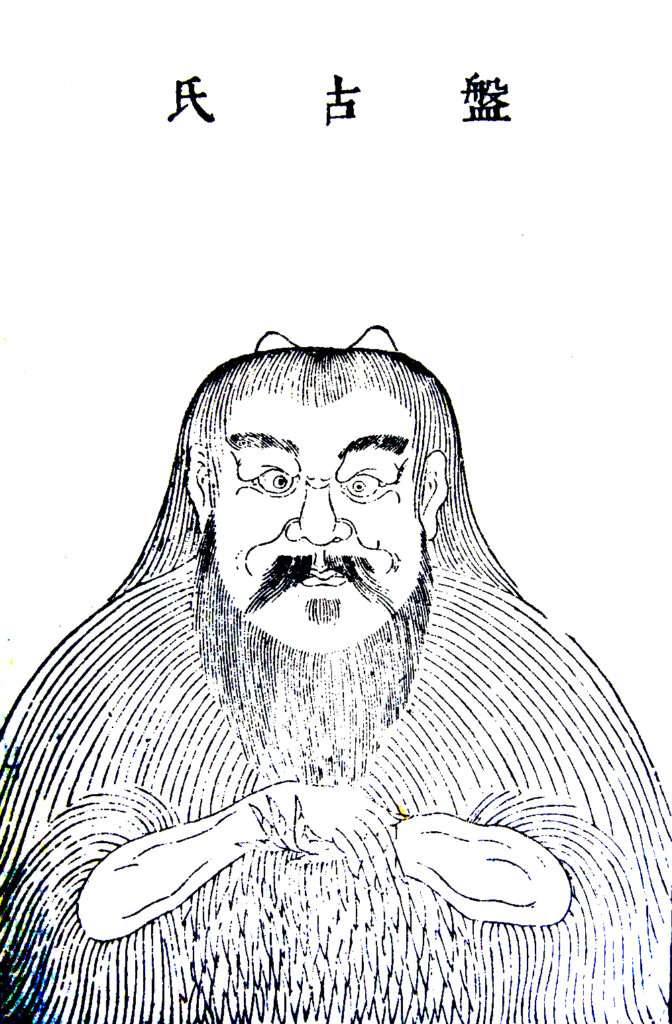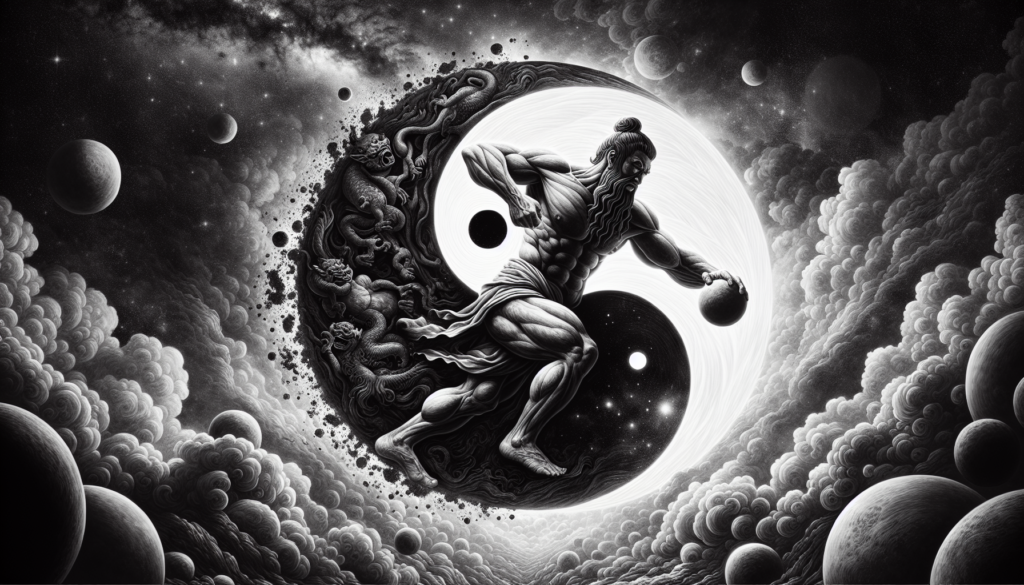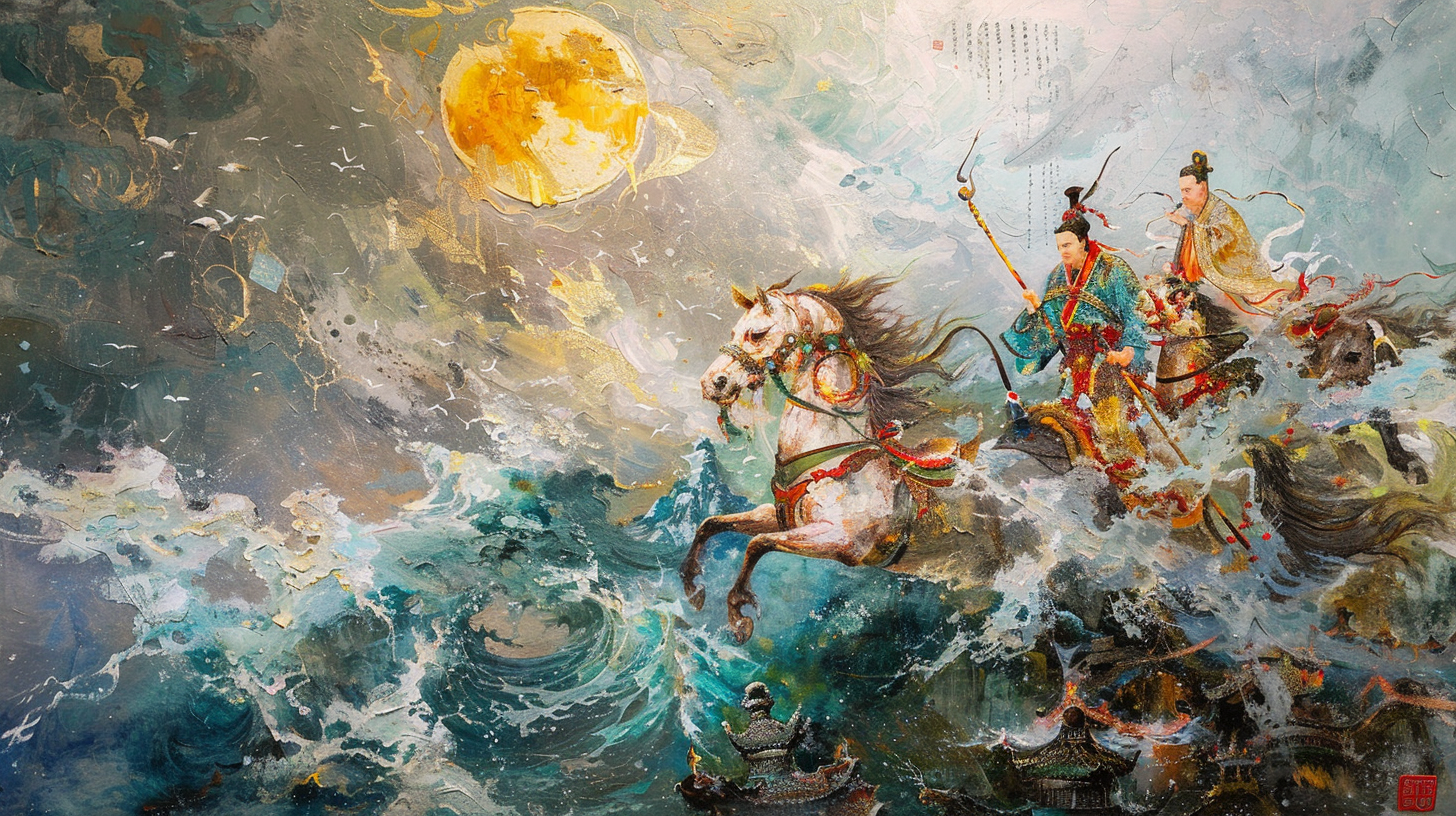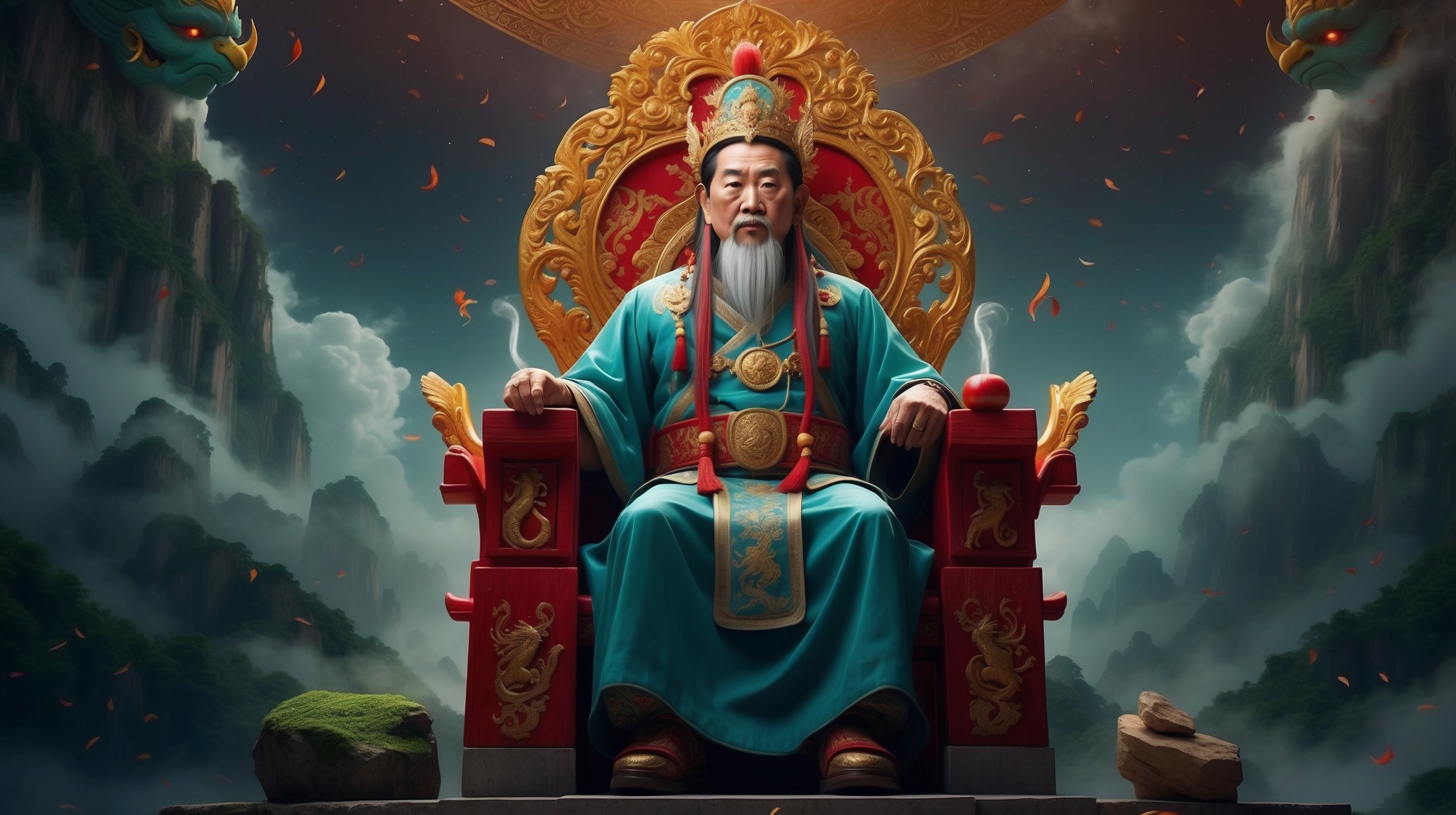AI-generated article summary
Who was Pan Gu, and how did he forge the Chinese universe from an enigmatic world egg? Our exploration uncovers the tale of this primordial giant, whose enduring labor separates and defines heaven and earth in ancient Chinese mythology. Through a lens of philosophical depth and cultural heritage, we delve into “Pan Gu and the World Egg” mythology, a legend of creation, balance, and ultimate sacrifice that continues to permeate China’s worldview.
Key Takeaways
Pan Gu is a central figure in Chinese mythology who emerged from a cosmic egg and created the world by separating heaven (yang) and earth (yin), eventually transforming into various elements of nature upon his death.
The Pan Gu myth embodies the Chinese philosophical concepts of harmony and balance, particularly through the symbolism of yin and yang, and has impacted Chinese societal values and views of the cosmos, emphasizing interconnectedness and the importance of balance in nature and society.
Pan Gu’s legacy continues to influence contemporary Chinese culture through literature, art, popular media, and festivals, serving as a symbol of creation and heritage while also sharing common themes with global creation myths, yet retaining unique aspects in its narrative.
The Genesis of the Cosmos According to Pan Gu
Pan Gu (盤古) stands as a monumental figure in Chinese mythology. He is the first living entity, a symbol of the imaginative expression of the world’s creation.
Pan Gu’s name itself holds significant meaning. It is comprised of the Chinese characters pán (盤), meaning “to coil,” and gǔ (古), meaning “ancient,” referring to his curled-up position inside the egg and his ancientness.
His myth symbolizes the world’s origin as perceived by the ancient Chinese community, reflecting their fundamental values.
Revered as the progenitor and ancestor of all beings, Pan Gu played a pivotal role in forming the cosmos. His monumental tasks included:
- Separating heaven and earth, holding them apart for 18,000 years
- Growing taller each day to maintain the separation between heaven and earth
- Creating the mountains, rivers, oceans, and sky, which form the foundation of the world
This establishes him as both a central figure and a prominent figure in cosmic creation. As the first living being in the universe, Pan Gu had no relatives or descendants, emphasizing his unique and solitary role in the creation of the world.
The narrative of Pan Gu is not just a tale of beginnings; it is a guide to understanding the complex structure of the universe through the lens of ancient Chinese belief. This enduring myth continues to resonate with modern audiences, offering insights into the philosophical and cultural foundations of Chinese civilization.
The Cosmic Egg and the Birth of Pan Gu

The tale of Pan Gu begins with something seemingly simple yet incredibly profound – a cosmic egg. This egg harbored a chaotic, formless primordial state for about 18,000 years. Within this egg, the principles of yin and yang balanced out, leading to the emergence of Pan Gu. This concept of the cosmic egg provides a definitive form within the whole of reality, centering the universe and giving it a definite form.
Unlike many other creation myths, the story of Pan Gu does not begin with the actions of a transcendent being or deity but with the hatching of a cosmic egg. This beginning, marked by the balance of yin and yang, sets the stage for a creation story that is uniquely Chinese. The cosmic egg’s concept encapsulates the universe’s essence before Pan Gu’s emergence, a state of chaos and potential brimming with the seeds of a new world.
The Monumental Task of Pan Gu

Emerging from the cosmic egg, Pan Gu embarked on a herculean task to shape the universe. His mission was to separate the primordial forces of yin and yang, intermingled in the egg. Yin, associated with the earth, darkness, femininity, and passivity, contrasted with yang, representing the heavens, light, masculinity, and activity. Pan Gu aimed to establish a balance that would allow the world to function harmoniously by separating these two forces.
Wielding his giant axe, a symbol of his strength and determination, Pan Gu divided the chaos into two distinct realms with each mighty swing: the earth, formed from the heavier yin elements, and the sky, created from the lighter yang elements. This separation marked the beginning of the world as we know it.
This was not a task completed in a day. For a period of 18,000 years, Pan Gu sustained the separation of heaven and earth by pushing up the sky. Each day, the earth, sky, and Pan Gu himself, grew ten feet higher. This narrative emphasizes the immense effort and time invested in creating the universe, a theme that differentiates the Pan Gu myth from many other creation stories.
The Ultimate Sacrifice of Pan Gu

After 18,000 years of shaping the universe, Pan Gu met his end. But his death was not just the end of a creator; Pan Gu’s body transformed into various elements of the natural world, serving as the basis for Earth’s creation.
His breath became the wind and clouds, his voice the thunder, his eyes the sun and moon. His body, too, served as the foundation of the earth:
- his head transformed into mountains
- his blood into rivers
- his muscles into fertile land
- his bones into valuable minerals
Every part of life is connected to Pan Gu. From the towering mountains to the flowing rivers, from the lush forests to the diverse animal kingdom, the legacy of Pan Gu lives on, reminding us of the divine origins of our natural world.
Alternative Versions of the Pan Gu Myth
While the core narrative of the Pan Gu myth remains consistent, there are several lesser-known variations that offer unique perspectives on the creation story. These alternatives showcase the richness and diversity of Chinese mythology.
One variation depicts Pan Gu as a primordial being who emerges from a lotus flower that grows from the navel of the first living being, known as the “Primal Man.” In this version, Pan Gu’s birth is linked to the concept of reincarnation and the cyclical nature of existence, highlighting the interconnectedness of all living things.
Some regional variations of the Pan Gu myth incorporate local deities and folklore. For example, in the Miao ethnic group’s version, Pan Gu is assisted by a celestial dog and a celestial chicken in the creation process. These animals play a crucial role in separating heaven and earth, adding a unique cultural flavor to the myth.
In another regional variation, Pan Gu is portrayed as a cosmic tree that grows between heaven and earth. As the tree grows taller, it pushes the two realms apart, creating the world as we know it. This version draws parallels between the creation of the universe and the growth of a tree, emphasizing the organic and nurturing aspects of the creation process.
These alternative versions of the Pan Gu myth not only showcase the creativity and imagination of ancient Chinese storytellers but also reflect the diverse cultural landscapes and belief systems within China. They demonstrate the adaptability of the myth and its ability to incorporate local elements while maintaining its core message of creation and cosmic order.
Pan Gu and Nüwa
While Pan Gu and Nüwa are both significant figures in Chinese mythology, they are typically portrayed as separate deities with distinct roles in the creation story. Pan Gu is solely responsible for the creation of heaven and earth, while Nüwa is depicted as a later deity who plays a crucial role in the creation of humans and the maintenance of the world.
In the classic Pan Gu myth, he emerges from the cosmic egg alone and separates the heavens and the earth through his divine efforts. After his death, his body transforms into various elements of the universe, forming the foundation of the world as we know it.
Nüwa, on the other hand, enters the mythological narrative after the earth and heavens have been formed. She is credited with creating humans and is often portrayed as a nurturing and protective deity. In one famous story, Nüwa repairs the broken pillars of heaven and stops the flooding of the earth, ensuring the stability and order of the world.
Although Pan Gu and Nüwa are not typically portrayed as siblings or collaborators in the creation process, their stories are interconnected and complementary. Together, they represent the divine forces responsible for the creation and maintenance of the universe, with Pan Gu laying the foundation and Nüwa building upon it to create life and ensure its continuity.
The inclusion of both Pan Gu and Nüwa in Chinese mythology highlights the importance of balance and the collaborative efforts of divine beings in the formation and preservation of the universe. While their roles may be distinct, they are both essential to the overall narrative of creation and cosmic order in Chinese mythology.
The symbolism of Yin and Yang in the Creation Myth
The Pan Gu creation story elegantly intertwines the elements of yin and yang, depicting them as essential forces that bring structure to the world and cosmos through their balance. Yin, associated with the moon, night, weakness, darkness, softness, and femininity, contrasts with Yang, which corresponds to the sun, day, strength, brightness, hardness, and masculinity. The left eye of this myth symbolizes the importance of balance between these two forces.
Reflections in Nature and Society
The principles of yin and yang extend beyond the realm of myth, influencing the balance of natural phenomena and social structures in Chinese philosophy. They have shaped indigenous organizational management and societal frameworks within ancient Chinese society, promoting a balance of opposing yet complementary forces. For example, the concept of yin and yang has been applied to traditional Chinese medicine, with the goal of balancing the body’s internal forces to maintain health and well-being.
Visual Representations of Pan Gu
Art and mythology have always been intertwined, and the Pan Gu myth is no exception. In art, Pan Gu is often depicted as a short, stout, hairy giant with a human face and rounded horns. He is usually represented holding a hammer and chisel or the sun and moon in his hands, symbolizing his role as the creator and shaper of the world. These visual elements embody the power and strength of Pan Gu, representing his fundamental role as the creator of the world.

The Artistic Interpretation of the Myth
Artistic interpretations of the Pan Gu myth simplify the complex stages of the creation story. They visually represent key moments, such as:
The cosmic egg
The birth of Pan Gu
Pan Gu’s task of separating yin and yang
Pan Gu’s death and transformation
These artistic creations relate the essence of the myth, typically depicted in broader cultural expressions, allowing us to experience the myth in a tangible form.
Artists in ancient China used sophisticated techniques like reflexive symmetry to integrate mythological figures such as Pan Gu into their art, suggesting a deep reverence and contemplation of the myth. Through these artistic interpretations, we see how the myth of Pan Gu continues to inspire and influence, its essence rumbling through the annals of time.

Pan Gu in Contemporary Culture
In today’s Chinese culture, Pan Gu is more than just a figure from an ancient myth; he is a symbol of creation. His story has found a place in literature, art, and popular culture, resonating with people across generations. The myth of Pan Gu not only explains the origins of the cosmos but also serves as a model for other myths and cultural expressions.
Pan Gu is considered a symbol of Chinese heritage and is invoked in rituals for good luck and prosperity. His narrative continues to be passed down through folktales and legends, a testament to its enduring relevance in Chinese folklore.
Festivals and Celebrations
Pan Gu’s influence extends to various festivals celebrated throughout southern China. His mythological contributions as a creator in Chinese culture are acknowledged and celebrated in these events. One notable example is the festival celebrating Pan Gu held from March 1-7 of the Lunar Calendar at the Pangu King Temple in Guangdong Province, where communities come together to honor his mythological contributions.
During the Shiling Pangu Cultural Festival, various activities are held in honor of Pan Gu, such as:
Blessing ceremonies
Lion dance competitions
Pangu dances
Exhibitions of intangible cultural heritage and photography
Through these celebrations, communities re-engage with the myth, reflecting the sacred time of creation in contemporary festivities.
Pan Gu’s Influence on Media and Literature
The story of Pan Gu has transcended the boundaries of folklore, making its cultural impact on various forms of global media and literature.
Pan Gu’s mythological legacy extends into modern pop culture and gaming. The character features in the MOBA game ‘Smite’ wielding creative and destructive powers, and his influence is woven into the thematic elements of the Pitioss Ruins in ‘Final Fantasy XV’. Additionally, the legendary figure has inspired the name of the infamous Chinese programming group, Pangu Team, and is also celebrated in ‘Age of Mythology: Titan’, showcasing his continued relevance in contemporary media.
Pan Gu’s story is also referenced in literature, such as in Gore Vidal’s novel ‘Creation’, where it is used to explore the significance of myths across cultures. The animated film ‘Pangu 盘古’ retells the myth for a young audience, underscoring the tale’s adaptability and continuous relevance.
Through these different forms of media and literature, we see how the Pan Gu myth continues to influence and inspire, reaching audiences far beyond its origins.
Comparative Analysis with Other Myths
The Pan Gu myth, while uniquely Chinese, shares themes with other global creation myths. Comparing these myths can provide insights into the common human experience and the universal themes that transcend cultural boundaries.
One interesting connection is the presence of encoded images of Pan Gu in ancient Maya art, suggesting a possible transcultural exchange of mythological figures. This connection warrants further exploration to understand the potential links between these two ancient cultures.
The Norse creation myth also shares similarities with the Pan Gu story. In Norse mythology, the world is formed from the body of a primordial being, Ymir, paralleling the story of Pan Gu. Both Norse and Chinese creation stories depict beings emerging from natural elements such as ice or mud, underlining a common theme of nature as a source of life.
Shared Themes in Global Creation Myths
Many creation myths, like that of Pan Gu, begin with a primordial chaos from which the world is formed. It’s a consistent motif in creation stories from various cultures, leading to the ordering of the cosmos. Some creation myths depict the universe coming into existence ex nihilo, or out of nothing, emphasizing the mysterious origins of existence.
These myths are not only religious in nature but can also exist in secular forms, reflecting similar existential themes in contemporary cultures. Some examples of these myths include:
- The narrative of land emerging from an infinite ocean
- The story of a creator god shaping the earth from clay or other materials
- The belief in a primordial chaos that existed before the creation of the world
These myths highlight the elemental separation between earth and water and the significance of the land-water boundary in human culture.
Unique Aspects of the Pangu Story
While sharing common themes with other creation myths, the Pangu myth also has its unique aspects. It uniquely centers around the solitary figure of Pangu, with no pantheon of gods or complex divine hierarchy involved in the creation process. The mythology of Pangu presents a creation story that unfolds over 18,000 years, indicating a cultural and philosophical perspective distinct from other creation narratives with regard to the passage of time. In this narrative, as pangu emerged, Pangu created the world as we know it today, and eventually, Pangu died. The transformation of pangu’s body played a significant role in the formation of the world’s elements.
This solitary figure and distinct perspective on time set the Pan Gu myth apart. It underlines the importance of individual effort, sacrifice, and the passage of time in the creation of the world. These unique aspects add depth to the Pan Gu myth, making it not just a story of creation, but a reflection of philosophical and cultural beliefs.
Summary
From the cosmic egg to the birth of Pan Gu, from his monumental task of separating yin and yang to his transformation into the various elements of the natural world, the Pan Gu myth presents a unique perspective on the creation of the universe. It not only narrates the origins of the cosmos but also serves as a guide to understanding the complex structure of the universe through the lens of ancient Chinese belief.
The enduring relevance of the Pan Gu myth in contemporary culture, its influence on media and literature, and its celebration in various festivals across China all attest to the power of this ancient tale. As we delve into the depths of the Pan Gu myth, we discover a world where the divine and the earthly realm are interconnected, where harmony emerges from duality, and where a solitary figure’s sacrifice gives birth to the cosmos.




One Response
Good, keep it up